新编大学基础英语综合教程第一册教案
全新版大学英语综合教程第一册教案-Unit1
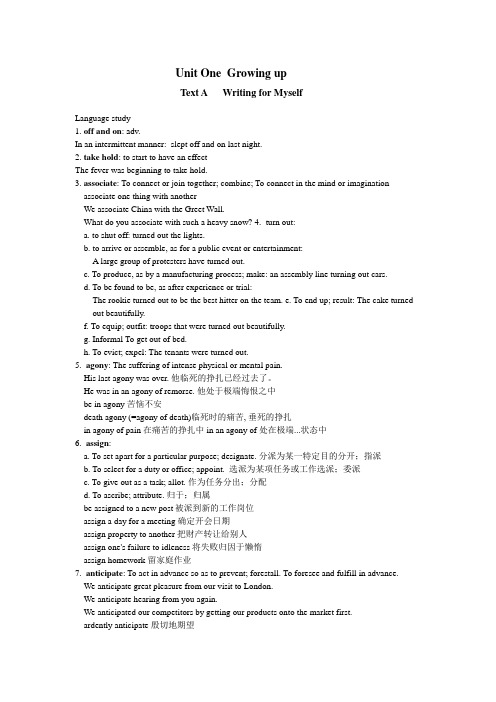
Unit One Growing upText A Writing for MyselfLanguage study1. off and on: adv.In an intermittent manner: slept off and on last night.2. take hold: to start to have an effectThe fever was beginning to take hold.3. associate: To connect or join together; combine; To connect in the mind or imagination associate one thing with anotherWe associate China with the Greet Wall.What do you associate with such a heavy snow? 4. turn out:a. to shut off: turned out the lights.b. to arrive or assemble, as for a public event or entertainment:A large group of protesters have turned out.c. To produce, as by a manufacturing process; make: an assembly line turning out cars.d. To be found to be, as after experience or trial:The rookie turned out to be the best hitter on the team. e. To end up; result: The cake turned out beautifully.f. To equip; outfit: troops that were turned out beautifully.g. Informal To get out of bed.h. To evict; expel: The tenants were turned out.5. agony: The suffering of intense physical or mental pain.His last agony was over. 他临死的挣扎已经过去了。
新编大学基础英语综合教程第1册课程设计
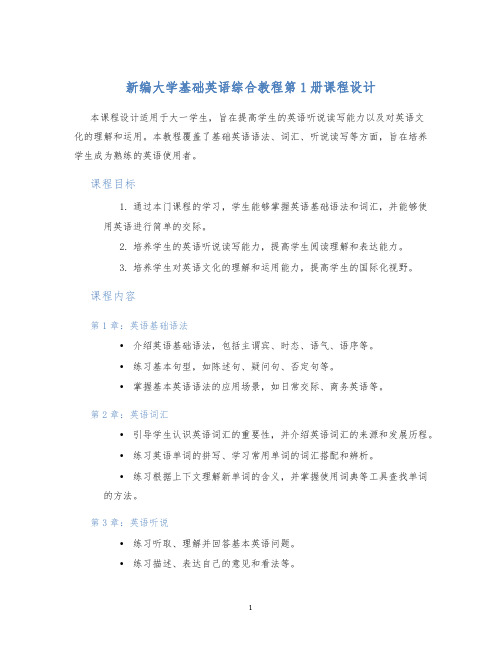
新编大学基础英语综合教程第1册课程设计本课程设计适用于大一学生,旨在提高学生的英语听说读写能力以及对英语文化的理解和运用。
本教程覆盖了基础英语语法、词汇、听说读写等方面,旨在培养学生成为熟练的英语使用者。
课程目标1.通过本门课程的学习,学生能够掌握英语基础语法和词汇,并能够使用英语进行简单的交际。
2.培养学生的英语听说读写能力,提高学生阅读理解和表达能力。
3.培养学生对英语文化的理解和运用能力,提高学生的国际化视野。
课程内容第1章:英语基础语法•介绍英语基础语法,包括主谓宾、时态、语气、语序等。
•练习基本句型,如陈述句、疑问句、否定句等。
•掌握基本英语语法的应用场景,如日常交际、商务英语等。
第2章:英语词汇•引导学生认识英语词汇的重要性,并介绍英语词汇的来源和发展历程。
•练习英语单词的拼写、学习常用单词的词汇搭配和辨析。
•练习根据上下文理解新单词的含义,并掌握使用词典等工具查找单词的方法。
第3章:英语听说•练习听取、理解并回答基本英语问题。
•练习描述、表达自己的意见和看法等。
•练习不同语音语调的模仿,提高听说的流利度。
第4章:英语阅读•练习阅读英语短文、新闻等,理解文章的主题、大意和细节。
•掌握阅读技巧,如寻找关键词、预测文章内容、注意上下文等。
•练习根据文章内容回答问题,培养学生的阅读理解能力。
第5章:英语写作•练习英语写作技巧,包括句型、段落结构和语法等。
•练习表达自己的思想和观点,如写作日记、个人陈述等。
•练习写作常见类型文章,如求职信、邀请信等。
教学方法本课程采用多种教学方法,包括听讲、阅读、写作、讨论、演讲等。
教师将会提供丰富的教学材料,如教科书、音频、视频、练习册,通过交互式教学,培养学生的英语听说读写能力。
评估方式学生的学习成果将通过考试、练习、作业等方式进行评估。
具体评估方式包括:1.阅读理解测试:检测学生阅读理解能力,学生需要根据文章回答相关问题。
2.语音语调测试:测试学生的语音语调模仿能力,学生需要模仿不同语音语调。
全新版大学英语综合教程第一册教案

College English Integrated CourseBook One Unit OneGrowing upLanguage study1.off and on: adv.In an intermittent manner: slept off and on last night.2.take hold: to start to have an effectThe fever was beginning to take hold.3.associate: To connect or join together; combine; To connect in the mind or imaginationassociate one thing with anotherWe associate China with the Greet Wall.What do you associate with such a heavy snow?4. turn out:a. to shut off: turned out the lights.b. to arrive or assemble, as for a public event or entertainment:A large group of protesters have turned out.c. To produce, as by a manufacturing process; make: an assembly line turning out cars.d. To be found to be, as after experience or trial:The rookie turned out to be the best hitter on the team.e. To end up; result: The cake turned out beautifully.f. To equip; outfit: troops that were turned out beautifully.g. Informal To get out of bed.h. To evict; expel: The tenants were turned out.5. agony: The suffering of intense physical or mental pain.His last agony was over. 他临死的挣扎已经过去了。
新编大学英语1教案

教学目标:1. 通过本单元的学习,使学生掌握相关词汇和语法知识,提高英语听说读写能力。
2. 培养学生运用英语进行交流的能力,增强学生的跨文化交际意识。
3. 帮助学生了解并关注社会热点话题,提高学生的思辨能力。
教学内容:1. 词汇:本单元重点词汇包括:environmental protection、energy-saving、public transportation等。
2. 语法:现在进行时态的构成和用法。
3. 听力:听懂日常生活中的对话,了解不同文化背景下的交流方式。
4. 阅读:阅读关于环境保护的文章,提高阅读速度和理解能力。
5. 写作:撰写一篇关于环境保护的短文,锻炼写作能力。
教学过程:一、导入1. 用PPT展示本单元的词汇和语法,让学生初步了解学习内容。
2. 引导学生思考:环境保护对于我们每个人来说意味着什么?二、词汇教学1. 教师带领学生朗读本单元的词汇,让学生熟悉发音和拼写。
2. 通过例句讲解词汇在句子中的用法,让学生学会运用词汇。
3. 进行词汇练习,巩固所学词汇。
三、语法教学1. 教师讲解现在进行时态的构成和用法,通过例句让学生理解。
2. 学生进行语法练习,巩固所学语法知识。
四、听力教学1. 播放听力材料,让学生听懂对话内容。
2. 针对听力材料进行提问,检验学生对对话内容的理解。
3. 学生分组讨论,分享听力材料中的文化差异。
五、阅读教学1. 学生阅读关于环境保护的文章,了解文章大意。
2. 教师提问,引导学生深入理解文章内容。
3. 学生分组讨论,分享阅读心得。
六、写作教学1. 教师讲解写作要求,指导学生撰写关于环境保护的短文。
2. 学生进行写作练习,教师给予个别指导。
3. 学生展示写作成果,互相评价。
七、课堂小结1. 教师对本单元的学习内容进行总结,强调重点和难点。
2. 学生分享学习心得,提出疑问。
教学反思:1. 本节课的教学内容丰富,教学方法多样,有助于提高学生的英语综合能力。
2. 学生在课堂上的参与度较高,能够积极参与讨论和练习。
新编大学英语综合教程第一册unit1教学案(附答案)

Unit 1Personal RelationshipIn-Class Reading The Gift of Life以生命相赠1 炸弹落在了这个小村庄里。
在可怕的越南战争期间,谁也不知道这些炸弹要轰炸什么目标,而它们却落在了一所由传教士办的小孤儿院内。
2 传教士和一两个孩子已经丧生,还有几个孩子受了伤,其中有一个小女孩,8岁左右,双腿被炸伤了。
3 几小时后,医疗救援小组到了。
医疗小组由一名年轻的美国海军医生和一名同样年轻的海军护士组成。
他们很快发现有个小女孩伤势严重。
显然,如果不立即采取行动,她就会因失血过多和休克而死亡。
4 他们明白必须给小女孩输血,但是他们的医药用品很有限,没有血浆,因此需要匹配的血型。
快速的血型测定显示两名美国人的血型都不合适。
而几个没有受伤的孤儿却有匹配的血型。
5 医生会讲一点越南语,护士会讲一点法语,但只有中学的法语水平。
孩子们不会说英语,只会说一点法语。
医生和护士用少得可怜的一点共同语言,结合大量的手势,努力向这些受惊吓的孩子们解释说,除非他们能输一些血给自己的小伙伴,否则她将必死无疑。
然后他们问孩子们是否有人愿意献血来救小女孩。
6 对医生和护士的请求,孩子们瞪大眼睛,一声不吭。
此时小病人生命垂危。
然而,只有这些受惊吓的孩子中有人自愿献血,他们才能够得到血。
过了好一会儿,一只小手慢慢地举了起来,然后垂了下去,一会儿又举了起来。
7 “噢,谢谢,”护士用法语说。
“你叫什么名字?”8 “兴,”小男孩回答道。
9 兴很快被抱到一张床上,手臂用酒精消毒后,针就扎了进去。
在整个过程中,兴僵直地躺着,没有出声。
10 过了一会儿,他发出了一声长长的抽泣,但立即用那只可以活动的手捂住了自己的脸。
11 “兴,疼吗?”医生问。
12 兴默默地摇了摇头,但一会儿忍不住又抽泣起来,并又一次试图掩饰自己的哭声。
医生又问是不是插在手臂上的针弄疼了他,兴还是摇了摇头。
13 但现在,偶尔的抽泣变成了持续无声的哭泣。
大学英语综合教程1教案
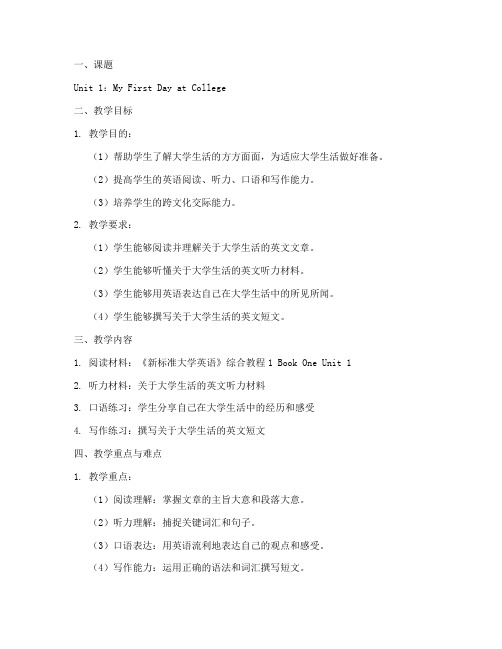
一、课题Unit 1:My First Day at College二、教学目标1. 教学目的:(1)帮助学生了解大学生活的方方面面,为适应大学生活做好准备。
(2)提高学生的英语阅读、听力、口语和写作能力。
(3)培养学生的跨文化交际能力。
2. 教学要求:(1)学生能够阅读并理解关于大学生活的英文文章。
(2)学生能够听懂关于大学生活的英文听力材料。
(3)学生能够用英语表达自己在大学生活中的所见所闻。
(4)学生能够撰写关于大学生活的英文短文。
三、教学内容1. 阅读材料:《新标准大学英语》综合教程1 Book One Unit 12. 听力材料:关于大学生活的英文听力材料3. 口语练习:学生分享自己在大学生活中的经历和感受4. 写作练习:撰写关于大学生活的英文短文四、教学重点与难点1. 教学重点:(1)阅读理解:掌握文章的主旨大意和段落大意。
(2)听力理解:捕捉关键词汇和句子。
(3)口语表达:用英语流利地表达自己的观点和感受。
(4)写作能力:运用正确的语法和词汇撰写短文。
2. 教学难点:(1)词汇理解:掌握与大学生活相关的词汇。
(2)语法运用:正确运用英语语法知识。
(3)跨文化交际:了解西方文化背景,提高跨文化交际能力。
五、教学过程1. 导入新课(1)教师简要介绍大学生活的相关背景,激发学生的学习兴趣。
(2)提问:学生对自己大学生活有什么期待?2. 阅读教学(1)学生阅读课文,了解文章主旨大意。
(2)教师讲解文章中的生词、短语和语法结构。
(3)学生分组讨论,分享阅读心得。
3. 听力教学(1)学生听关于大学生活的英文听力材料,捕捉关键词汇和句子。
(2)教师总结听力材料中的主要内容,并引导学生进行复述。
4. 口语练习(1)学生分组讨论,分享自己在大学生活中的经历和感受。
(2)教师鼓励学生用英语表达自己的观点,并给予适当的评价和指导。
5. 写作教学(1)学生根据课文内容,撰写关于大学生活的英文短文。
(2)教师批改作文,指出学生的优点和不足,并进行针对性指导。
新编大学基础英语综合教程第一册教案
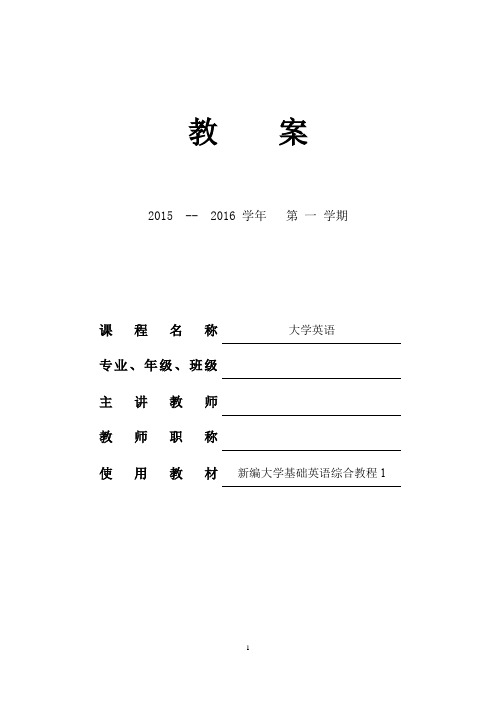
教学方式、手段、媒介:
教学方式(Teaching method):
1. lecture
2. role play
讨论、思考题、作业:
1. Organize the students into groups to complete theinformationfor your group members as well as yourself, which may include:
Then ask one student from each group to report the results of their interview.
efulExpressions:*
1) at a wedding
2) at a disco
3) on holiday
4) be/come from
5) hi, there
6) date of birth
7) in lower case
8) in capitals
2. Language Focus on?
Reading
Understand short texts describing jobs and morning routines and read a snack bar menu.
Language quality
Use determiners and possessive pronouns, the Present Simple.
2. Assign the exercise after the text.
新编大学基础英语综合教程第一册教案

新编⼤学基础英语综合教程第⼀册教案本科课程教案2017-2018 学年(第 1 学期)课程名称:⼤学英语CI课程性质:□通识必修课□⼤类基础课□专业核⼼课□专业拓展课□通识限选课□通识任选课授课班级:17产品设计1班(32⼈)、环境设计七班(30⼈)学⽣数:共62⼈授课教师:庞海才学分/学时:6/75学时分配:理论讲授学时,课堂讨论学时实验/课内实践学时,在线学习学时课程设计(周)系(教研室)负责⼈(签名):主管教学院长(签名):审核通过⽇期:年⽉⽇Unit 4 What’s On?I.教学⽬标ObjectivesStudents will be able to:Talk about free time activitiesMatch descriptions to photosIntroduce and practise the use of the -ing verb form after go, like and love Use expressions of frequency to talk about habits in a quizII. 课时安排Time Allotment(体现重点、难点)1st period:Lesson 1)2nd period: Lesson 23rd period: Lesson 34th period: Lesson 4III. 教学⽅法与⼿段Teaching MethodologyStudent-centered approachStudent-centered learning requires students to be active, responsible participants in their own learning. Instead of lecturing through the whole class, the teacher t akes students interests into account, follows their passions, capitalizes on their strengths and helps students form a strong learning community.Task-based approachThe main aim of this approach to learning is task completion. Usually, relevant and interesting tasks are set by the teacher and students are expected to draw on their pre-existing knowledge of English to complete the task.IV. 教学内容及过程Tasks and ProcessLesson 1 Time OutLexical PreparationVocabulary &Listening1. Work in pairs. Find phrases to describe the photos below.Key:a. I go swimming.b. We go to concerts.c. We go rollerblading on the seafront.d. I sit in a café and read the paper.e. We spend hours playing computer games.f. I work out in the gym.2. Work in pairs. Look at the above list and ask your partner: What do you do in your freetime?3. Listen to Nikki and Martin answering the same questions. Tick the activities they mention.4.Listen again. Match the answers to the questions and write the name of the person who’s speaking (Nikki or Martin). Questions:1. What do you do in your free time?2. What do you like doing on Sundays?3. How often do you go to concerts / the cinema?Lesson 2 Going OutSpeaking1. Work in pairs. Match the questions with the answers.2. Ask your classmates the questions. Find the person who is most similar to you.Listening1. Listen to a telephone conversation and answer the questions.1. Are the two people friends?a) yes b) no2. Where is the woman?a) at home b) in the office c) in the street3. Is she busy?a) yes b) no4. Why does the man phone the woman?a) to talk about workb) to invite her for a drinkc) to ask for help2. Match the questions and the answers.1. Are you busy? a) I’m visiting some friends.2. What are you doing? b) I’m in the office.3. What are you doing here? c) I’m writing a report.Listen and check.Practice4. Listen to their mobile phone conversations. Are they telling the truth?Conversation 1 Conversation 2Conversation 3 Conversation 45. Complete the dialogue. Listen and check.1. A: Hi, ______ you working?B: No, I _______. ______ having a drink with a friend .What ______ you doing? Are you busy?A: No, I _______.B: Well, come and have a drink with us!2. C: Hi, ______ you watching the football?D: Yes, I ______. ______ watching it with some friends in the pub.C: _______ Rob watching it with you?D: No, he _______. He’ s doing some work at home.6. Match the dialogues with two of the photos.7. Work in pairs. Write similar dialogues for the other two photos. Practise reading them with your partner.8. Translate the following sentences into English.1. 玛丽亚的母亲正在打扫客厅Maria’s mother is cleaning the sitting room.2. —孩⼦们在做作业吗?—不, 他们在踢⾜球。
新标准大英第一册Unit1-Unit5综合教程教案
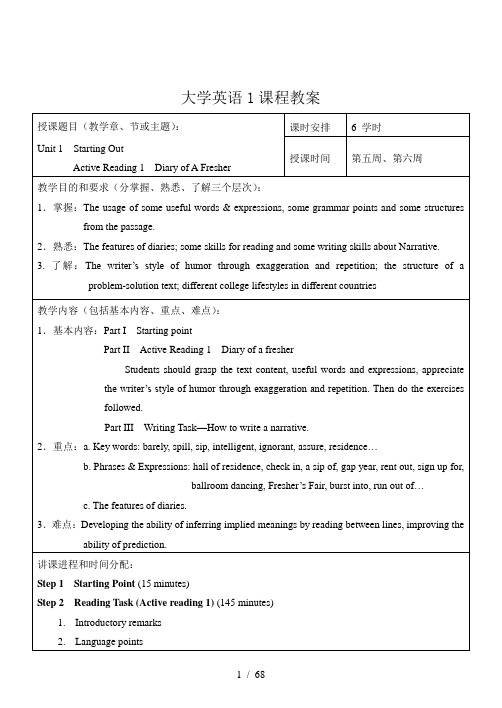
大学英语1课程教案Unit 1 Starting OutTeaching Content: Diary of A FresherLesson Type: Intensive Reading (New Standard College English Book 1)Total Time: 4.5 HoursClass/Object: Freshman (the first term)Teaching Procedures:Step 1Starting Point(15 mins)1. What do you expect to learn in the university?2.Work in pairs. Look at the photo of a university. Choose words to describe it.And then think of words to describe your own college.3. Work in pairs. Brainstorm college education objectives and what are important to you.☐finding a girlfriend / boyfriend☐studying hard and learning a lot☐meeting people and making friends☐getting a good job when you graduate☐having fun☐growing up and becoming independent☐going to parties☐doing lots of sport☐reading widely☐learning new skills and having new experiencesStep 2Introductory remarks (10 mins)How to write a diary in English1. Format:a. Write down the date, the day and the weather on the first line. The date and theday are on the left, while the weather is on the right.b. Write the body part. Write this part on the second line.2. Person:Write the diary in the first person.3. Tense:a. Past tense;b. Present tense;c. Future tense.4. Order:Write the diary in chronological order.5. StyleCasual and informal: express a personal viewpoint with reactions, reflections andfeelings.●Find out the features of Diary of a fresher.The text is a diary. There is a long tradition of writing and sometimes publishing diaries in Western literature. The text has typical features of a diary. It is a first person account, written daily about events in which the writer has participated. It is written ina casual, informal style, expressing a personal viewpoint with reactions, reflections andfeelings. The writer’s personality is evident, in this case through humor and exaggeration. It is written in the first person and with the simple present tense.Step 3 Predict the contents of the text from the title. (10 mins)Step 4 Language Points and Difficult Sentences (125 mins)⏹SundayLanguage Points1. fresher n.(BrE) first-year student / fresher (in first months of study)second-year studentthird-year student / final-year student (of a three-year program)fourth-year student / final-year student (of a four-year program) (AmE) freshmansophomorejuniorsenior2. residence n. [C] (fml)➢ a person’s home; the place where someone lives 住所;住宅➢the official house of a government minister or other public and official figure 官邸;公馆➢the fact of living in a particular place 居住;居留期间e.g. They took up residence abroad. 他们定居了国外。
新编大学英语第一册教案

课时安排:2课时教学目标:1. 培养学生的英语阅读能力,提高阅读速度和理解力。
2. 扩大学生词汇量,掌握基本语法知识。
3. 培养学生的英语口语表达能力和听力理解能力。
4. 增强学生的英语写作能力,提高书面表达能力。
教学内容:1. 单元主题:日常生活中的英语表达2. 课文:《日常生活中的英语表达》教学重点:1. 课文中的词汇和短语2. 课文中的语法知识3. 课文中的句型和结构4. 课文中的听力理解技巧教学难点:1. 词汇的记忆和运用2. 语法知识的理解和运用3. 听力理解的准确性教学准备:1. 课文教材2. 词汇卡片3. 语法讲解PPT4. 听力材料教学过程:第一课时:一、导入1. 利用图片或视频,展示与课文主题相关的日常生活场景,激发学生的兴趣。
2. 引导学生谈论自己在日常生活中遇到的英语表达,引出课文主题。
二、阅读1. 学生阅读课文,了解课文大意。
2. 教师讲解课文中的生词、短语和语法知识。
3. 学生跟读课文,模仿语音、语调。
三、讨论1. 教师提出与课文相关的问题,引导学生进行讨论。
2. 学生分组讨论,分享自己的观点和经验。
四、听力1. 学生听课文录音,回答相关问题。
2. 教师讲解听力技巧,提高学生的听力理解能力。
第二课时:一、复习1. 复习第一课时的内容,检查学生对课文的理解程度。
2. 学生互相提问,巩固所学知识。
二、口语1. 学生进行角色扮演,模拟课文中的场景,练习口语表达。
2. 教师给予指导和评价。
三、写作1. 学生根据课文主题,写一篇短文。
2. 教师讲解写作技巧,指导学生提高写作能力。
四、总结1. 教师总结本节课的主要内容,强调重点和难点。
2. 学生分享自己的学习心得。
教学评价:1. 学生在课堂上的参与度和表现。
2. 学生对课文内容的掌握程度。
3. 学生在口语和写作方面的进步。
教学反思:1. 根据学生的学习情况,调整教学内容和方法。
2. 关注学生的学习需求,提高教学效果。
大学基础英语1教案

教学对象:大学一年级新生教学目标:1. 掌握基本的英语问候语和自我介绍的表达方式。
2. 能够在简单的社交场合进行基本的交流。
3. 培养学生对英语学习的兴趣,提高学习积极性。
教学重点:- 英语问候语的用法- 自我介绍的常用句型- 简单社交场合的交流技巧教学难点:- 正确发音和语调- 在实际交流中灵活运用所学句型教学方法:- 任务型教学- 小组讨论- 角色扮演- 互动练习教学准备:- 教材:《新编大学基础英语》第1册- 多媒体课件- 录音设备- 小组讨论材料教学过程:第一课时1. 导入(5分钟)- 教师用英语进行自我介绍,并询问学生是否愿意用英语进行简单的自我介绍。
- 引导学生思考:在社交场合,如何用英语进行问候和自我介绍?2. 新授(25分钟)- 教师展示多媒体课件,讲解英语问候语的用法,如“Goodmorning/afternoon/evening”、“Hello”等。
- 教师示范自我介绍的常用句型,如“Nice to meet you. My name is...”等。
- 学生跟读并模仿。
3. 练习(15分钟)- 学生两人一组,互相练习问候和自我介绍。
- 教师巡视指导,纠正发音和语调。
4. 角色扮演(10分钟)- 学生分组进行角色扮演,模拟在社交场合进行问候和自我介绍的场景。
- 教师点评并给予指导。
第二课时1. 复习(5分钟)- 教师带领学生复习上一节课学到的问候语和自我介绍句型。
2. 拓展(15分钟)- 教师展示多媒体课件,讲解更多实用的社交场合英语表达,如询问对方姓名、职业等。
- 学生跟读并模仿。
3. 小组讨论(10分钟)- 学生四人一组,讨论在社交场合如何用英语进行交流。
- 教师巡视指导,鼓励学生积极参与讨论。
4. 总结(5分钟)- 教师总结本节课的学习内容,强调英语问候语和自我介绍的重要性。
- 鼓励学生在日常生活中多使用英语进行交流。
课后作业:1. 用英语写一篇自我介绍,内容包括姓名、年龄、专业等。
全新版大学英语综合教程第一册教案
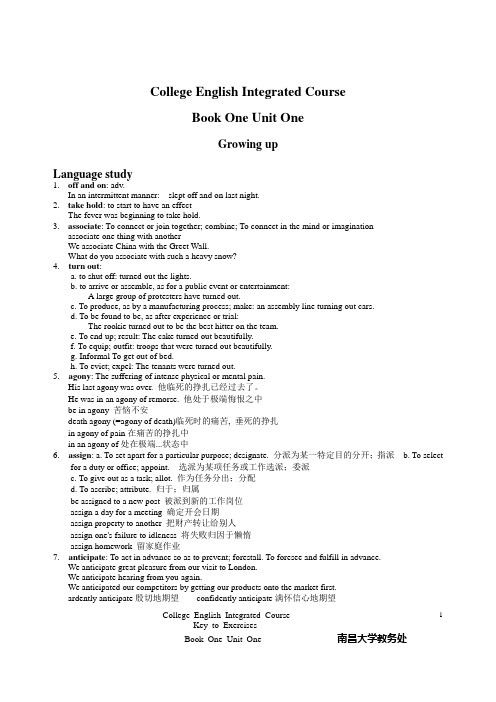
College English Integrated Course Key to Exercises 1College English Integrated CourseBook One Unit OneGrowing upLanguage study1.off and on: adv.In an intermittent manner: slept off and on last night.2.take hold: to start to have an effectThe fever was beginning to take hold.3.associate: To connect or join together; combine; To connect in the mind or imaginationassociate one thing with anotherWe associate China with the Greet Wall.What do you associate with such a heavy snow?4. turn out:a. to shut off: turned out the lights.b. to arrive or assemble, as for a public event or entertainment:A large group of protesters have turned out.c. To produce, as by a manufacturing process; make: an assembly line turning out cars.d. To be found to be, as after experience or trial:The rookie turned out to be the best hitter on the team.e. To end up; result: The cake turned out beautifully.f. To equip; outfit: troops that were turned out beautifully.g. Informal To get out of bed.h. To evict; expel: The tenants were turned out.5. agony: The suffering of intense physical or mental pain.His last agony was over. 他临死的挣扎已经过去了。
全新版大学英语1电子教案
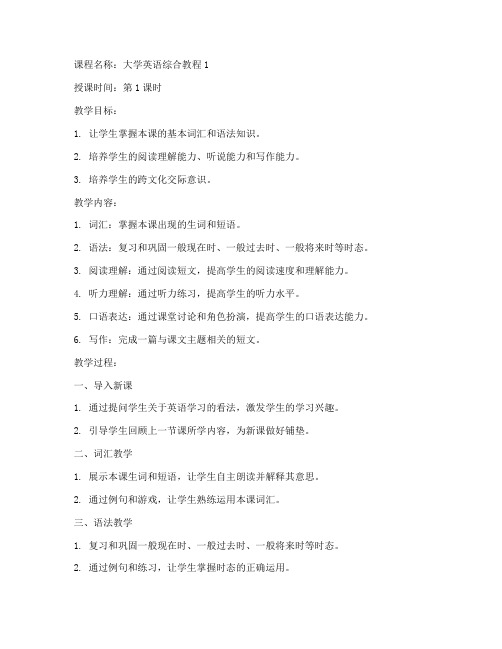
课程名称:大学英语综合教程1授课时间:第1课时教学目标:1. 让学生掌握本课的基本词汇和语法知识。
2. 培养学生的阅读理解能力、听说能力和写作能力。
3. 培养学生的跨文化交际意识。
教学内容:1. 词汇:掌握本课出现的生词和短语。
2. 语法:复习和巩固一般现在时、一般过去时、一般将来时等时态。
3. 阅读理解:通过阅读短文,提高学生的阅读速度和理解能力。
4. 听力理解:通过听力练习,提高学生的听力水平。
5. 口语表达:通过课堂讨论和角色扮演,提高学生的口语表达能力。
6. 写作:完成一篇与课文主题相关的短文。
教学过程:一、导入新课1. 通过提问学生关于英语学习的看法,激发学生的学习兴趣。
2. 引导学生回顾上一节课所学内容,为新课做好铺垫。
二、词汇教学1. 展示本课生词和短语,让学生自主朗读并解释其意思。
2. 通过例句和游戏,让学生熟练运用本课词汇。
三、语法教学1. 复习和巩固一般现在时、一般过去时、一般将来时等时态。
2. 通过例句和练习,让学生掌握时态的正确运用。
四、阅读理解1. 让学生阅读短文,并回答问题,检验学生的阅读理解能力。
2. 引导学生分析短文的结构和写作手法。
五、听力理解1. 播放听力材料,让学生听并回答问题。
2. 分析听力材料,提高学生的听力水平。
六、口语表达1. 通过课堂讨论,让学生发表自己的观点。
2. 通过角色扮演,提高学生的口语表达能力。
七、写作1. 分析写作要求,让学生明确写作方向。
2. 通过小组讨论,让学生互相交流写作思路。
3. 指导学生完成短文写作。
八、归纳小结1. 总结本课所学内容,帮助学生巩固知识。
2. 引导学生思考如何将所学知识应用到实际生活中。
九、作业布置1. 完成本课的课后练习。
2. 预习下一节课的内容。
教学评价:1. 通过课堂提问、练习和作业,评价学生的学习效果。
2. 关注学生的口语表达和写作能力,给予及时指导和反馈。
教学反思:1. 根据学生的学习情况,调整教学策略,提高教学效果。
《全新版大学英语综合教程》第1册教案设计

2.Master the key language points and grammatical structures in the test;
3. Conduct a series of reading, listening, speaking and writing activities related to the
off and on, take hold, turn out, out of date, face up to, put down, what’s more, hold back,
(2) Key Grammar and Structures (重点语法及结构)
a. come to sb. off and on……
(5) Neither Doris nor I had ever eaten spaghetti, and none of the adults had enough experience to be good at it.
(6) I was preparing myself for a command to report to Mr. Fleagle immediately after school fordisciplinewhen I saw him lift my paper form his desk and knock for the class’s attention.
(2) Until then I’d been bored by everything associated with English courses.
(3) I hated the assignments to turn out long, lifeless paragraphs that were agony for teachers to read and for me to write.
新编大学英语第一册教案
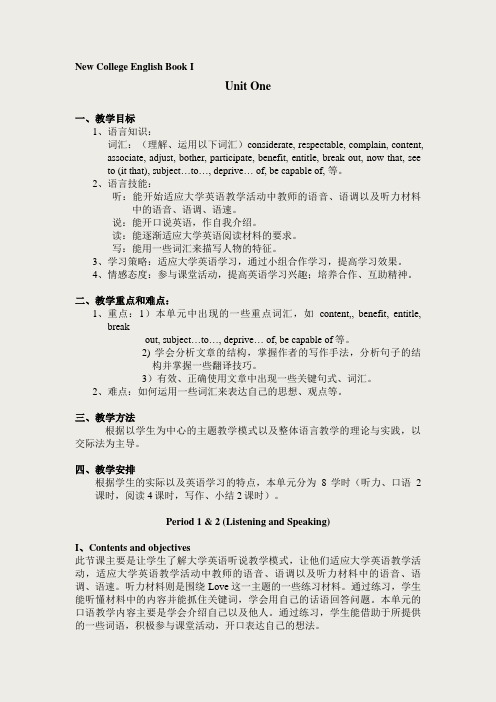
New College English Book IUnit One一、教学目标1、语言知识:词汇:(理解、运用以下词汇)considerate, respectable, complain, content, associate, adjust, bother, participate, benefit, entitle, break out, now that, see to (it that), subject…to…, deprive… of, be capable of, 等。
2、语言技能:听:能开始适应大学英语教学活动中教师的语音、语调以及听力材料中的语音、语调、语速。
说:能开口说英语,作自我介绍。
读:能逐渐适应大学英语阅读材料的要求。
写:能用一些词汇来描写人物的特征。
3、学习策略:适应大学英语学习,通过小组合作学习,提高学习效果。
4、情感态度:参与课堂活动,提高英语学习兴趣;培养合作、互助精神。
二、教学重点和难点:1、重点:1)本单元中出现的一些重点词汇,如content,, benefit, entitle,breakout, subject…to…, deprive… of, be capable of等。
2) 学会分析文章的结构,掌握作者的写作手法,分析句子的结构并掌握一些翻译技巧。
3)有效、正确使用文章中出现一些关键句式、词汇。
2、难点:如何运用一些词汇来表达自己的思想、观点等。
三、教学方法根据以学生为中心的主题教学模式以及整体语言教学的理论与实践,以交际法为主导。
四、教学安排根据学生的实际以及英语学习的特点,本单元分为8学时(听力、口语2课时,阅读4课时,写作、小结2课时)。
Period 1 & 2 (Listening and Speaking)I、Contents and objectives此节课主要是让学生了解大学英语听说教学模式,让他们适应大学英语教学活动,适应大学英语教学活动中教师的语音、语调以及听力材料中的语音、语调、语速。
《新编实用英语综合教程》第1册 第1单元教案

2. Important words and expressions in passages.
3. The skills in reading and translating.
4. Writing focus: Learning to write personal i年月日
教案首页
第_1_单元课授课时间:
课程名称
COLLEGE ENGLISH
专业班级
层次
授课教师
职称
课型
小
学时
10
授课题目(章、节)
UNIT 1 BOOK 1
授课方式
CLASSROOM TEACHING
教材及主要参考书
T:高教社《新编实用英语综合教程》第1册
R:高教社《新编实用英语教师参考书》第1册
教学目的与要求:
1. Learn how to orally greet and introduce others when meeting people.
2. Practice the listening comprehension to greet and introduce people with various relationships.
3. Read the passages about the way foreign people meet and greet each other, both in formal and informal situations.
4. Learn useful words, expressions as well as language points.
全新版大学英语综合教程第1册教案设计
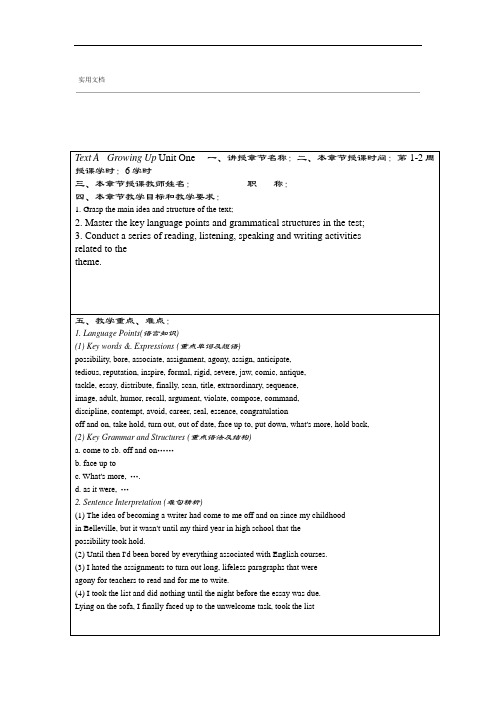
(精讲)Section A.) 15 minutes导入Step One Pre-reading Activities (Step Two While-reading Activities
) 120 minutes语言知识1. Language Points() 40 minutes难句精析2. Sentence Interpretation (Step Three Post-reading Activities 80 minutes
image, adult, humor, recall, argument, violate, compose, command,
discipline, contempt, avoid, career, seal, essence, congratulation
off and on, take hold, turn out, out of date, face up to, put down, what's more, hold back,
in Belleville, but it wasn't until my third year in high school that the
possibility took hold.
(2) Until then I'd been bored by everything associated with English courses.
3. Conduct a series of reading, listening, speaking and writing activities
related to the
theme.
五、教学重点、难点:
1. Language Points(语言知识)
全新版大学英语综合教程第一册教学案
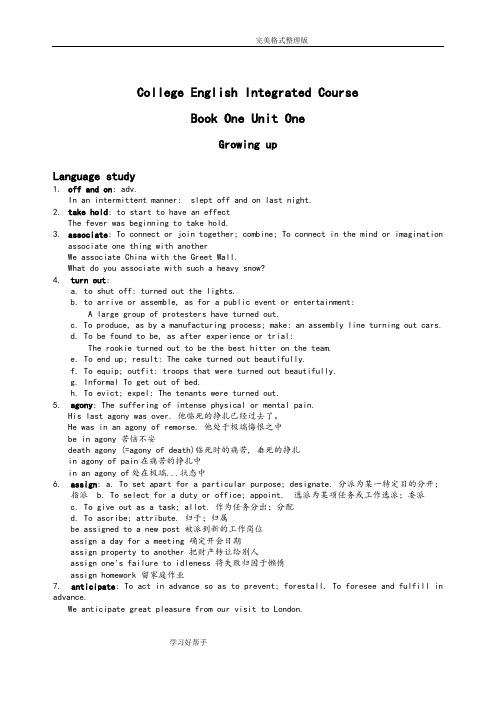
College English Integrated CourseBook One Unit OneGrowing upLanguage study1.off and on: adv.In an intermittent manner: slept off and on last night.2.take hold: to start to have an effectThe fever was beginning to take hold.3.associate: To connect or join together; combine; To connect in the mind or imaginationassociate one thing with anotherWe associate China with the Greet Wall.What do you associate with such a heavy snow?4. turn out:a. to shut off: turned out the lights.b. to arrive or assemble, as for a public event or entertainment:A large group of protesters have turned out.c. To produce, as by a manufacturing process; make: an assembly line turning out cars.d. To be found to be, as after experience or trial:The rookie turned out to be the best hitter on the team.e. To end up; result: The cake turned out beautifully.f. To equip; outfit: troops that were turned out beautifully.g. Informal To get out of bed.h. To evict; expel: The tenants were turned out.5. agony: The suffering of intense physical or mental pain.His last agony was over. 他临死的挣扎已经过去了。
- 1、下载文档前请自行甄别文档内容的完整性,平台不提供额外的编辑、内容补充、找答案等附加服务。
- 2、"仅部分预览"的文档,不可在线预览部分如存在完整性等问题,可反馈申请退款(可完整预览的文档不适用该条件!)。
- 3、如文档侵犯您的权益,请联系客服反馈,我们会尽快为您处理(人工客服工作时间:9:00-18:30)。
新编大学基础英语综合教程第一册教案-CAL-FENGHAI-(2020YEAR-YICAI)_JINGBIAN本科课程教案2017-2018 学年(第 1 学期)课程名称:大学英语CI课程性质:□通识必修课□大类基础课□专业核心课□专业拓展课□通识限选课□通识任选课授课班级:17产品设计1班(32人)、环境设计七班(30人)学生数:共62人授课教师:庞海才学分/学时: 6/75学时分配:理论讲授学时,课堂讨论学时实验/课内实践学时,在线学习学时课程设计(周)系(教研室)负责人(签名):主管教学院长(签名):审核通过日期:年月日Unit 4 What’s On?I.教学目标ObjectivesStudents will be able to:➢Talk about free time activities➢Match descriptions to photos➢Introduce and practise the use of the -ing verb form after go, like and love➢Use expressions of frequency to talk about habits in a quizII. 课时安排Time Allotment(体现重点、难点)1st period:Lesson 1)2nd period: Lesson 23rd period: Lesson 34th period: Lesson 4III. 教学方法与手段 Teaching Methodology➢Student-centered approachStudent-centered learning requires students to be active, responsible participants in their own learning. Instead of lecturing through the whole class, the teacher t akes students interests into account, follows their passions, capitalizes on their strengths and helps students form a strong learning community.➢Task-based approachThe main aim of this approach to learning is task completion. Usually, relevant and interesting tasks are set by the teacher and students are expected to draw on their pre-existing knowledge of English to complete the task.IV. 教学内容及过程Tasks and ProcessLesson 1 Time Out➢Lexical Preparation➢Vocabulary &Listening1. Work in pairs. Find phrases to describe the photos below.Key:a. I go swimming.b. We go to concerts.c. We go rollerblading on the seafront.d. I sit in a café and read the paper.e. We spend hours playing computer games.f. I work out in the gym.2. Work in pairs. Look at the above list and ask your partner: What do you do in your free time?3. Listen to Nikki and Martin answering the same questions. Tick the activities they mention.4.Listen again. Match the answers to the questions and write the name of the person w ho’s speaking (Nikki or Martin).Questions:1. What do you do in your free time?2. What do you like doing on Sundays?3. How often do you go to concerts / the cinema?Lesson 2 Going OutSpeaking1. Work in pairs. Match the questions with the answers.2. Ask your classmates the questions. Find the person who is most similar to you.Listening1. Listen to a telephone conversation and answer the questions.1. Are the two people friendsa) yes b) no2. Where is the womana) at home b) in the office c) in the street3. Is she busya) yes b) no4. Why does the man phone the woman?a) to talk about workb) to invite her for a drinkc) to ask for help2. Match the questions and the answers.1. Are you busy a) I’m visiting some friends.2. What are you doing b) I’m in the office.3. What are you doing here c) I’m writing a report.Listen and check.Practice4. Listen to their mobile phone conversations. Are they telling the truth?Conversation 1 Conversation 2Conversation 3 Conversation 45. Complete the dialogue. Listen and check.1. A: Hi, ______ you working?B: No, I _______. ______ having a drink with a friend .What ______ you doing Are you busyA: No, I _______.B: Well, come and have a drink with us!2. C: Hi, ______ you watching the football?D: Yes, I ______. ______ watching it with some friends in the pub.C: _______ Rob watching it with you?D: No, he _______. He’ s doing some work at home.6. Match the dialogues with two of the photos.7. Work in pairs. Write similar dialogues for the other two photos. Practise reading them with your partner.8. Translate the following sentences into English.1. 玛丽亚的母亲正在打扫客厅Maria’s mother is cleaning the sitting room.2. —孩子们在做作业吗?—不, 他们在踢足球。
—Are the children doing their homework—No. They are playing football.3. —露西在做什么?—她正在游泳。
—What is Lucy doing?—She is swimming.4. —你这是去哪里?—我去超市。
—Where are you going—I’m going to the supermarket.5. 萨姆和他父亲正在打羽毛球。
Sam and his father are playing badminton.1. Listen and repeat. Notice the difference between the pronunciation of the two hellos.2. Listen and decide if the hello is on the phone (a) or face-to-face (b).3. Work in pairs. Practise answering the phone. Ask your partner these questions.1. Where are you?2. What are you doing?Language Focusgo, like, love + -ing1. Complete these sentences so that they are true for you.1. I go every weekend.2. I like on Sunday.3. I love with my friends.2. Complete these questions and then ask your partner.1. What you do at the weekend?2. What you like on Sunday?1. Read the questions and choose the best answer for you. Then ask your partner.2. Work in pairs. Ask your partner the questions in the quiz.3. What do you think your partner is Look at the answers on page 200 and find out. Do you agree with the answersLesson 3 At the MoviesReading1.Work in pairs. Match each film type to one of the posters.• an action film poster • a science fiction film• a love story • a thriller• a musical • a comedy2.Discuss these questions.1. What kind of films do you like?2. Have you got a favorite film Or a favorite actor or actress3. Do you like watching films at the cinema or do you prefer watching videos at home?4. Are there any cinemas in your town that show films in English?3. Look at these film reviews. Match each review to a film type.4. Are these sentences true Write yes or no.1. Double Take is about two sisters.2. Year Zero is about the past.3. The story in Roses Only Live One Day happens in France.4. The special effects in Year Zero are very good.5. Double Take is about a criminal.6. Roses Only Live One Day is about an old couple.5. Answer these questions.1. Which film would you like to see2. Which would your partner like to see?6. Translate the following sentences into English.1.我的朋友玛吉是一位性格极好的女人。
